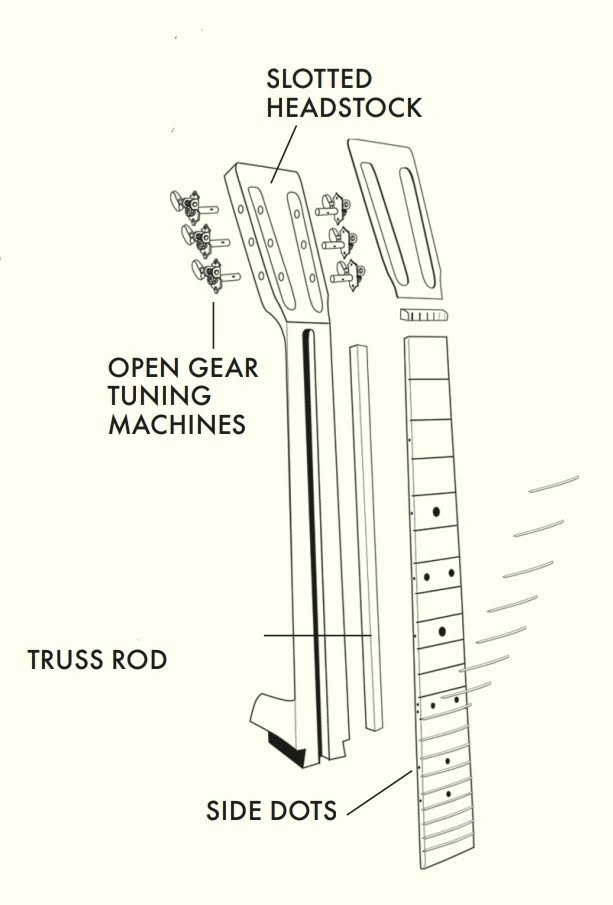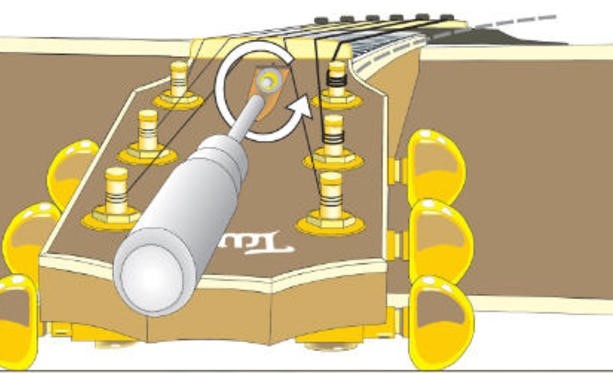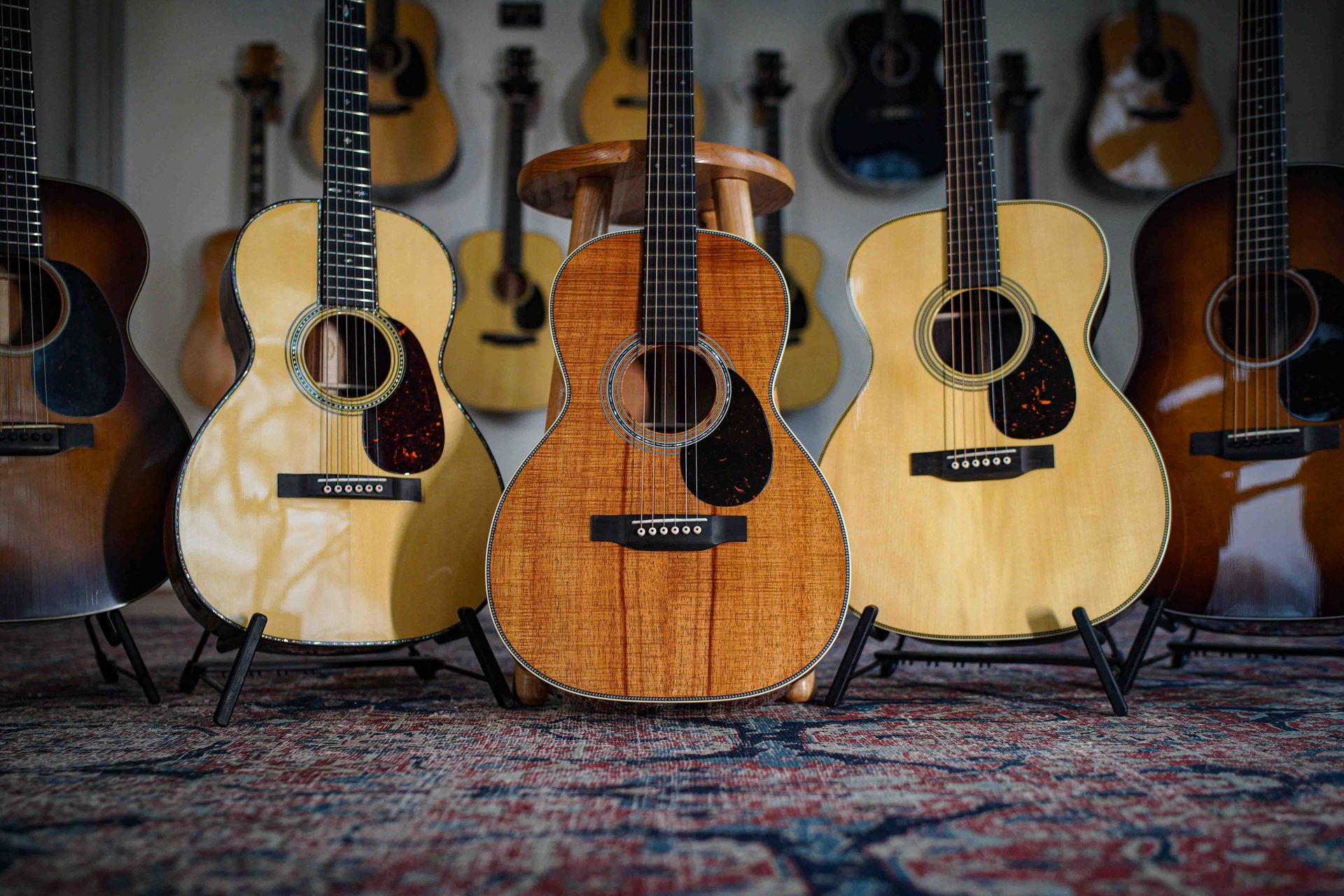Where's the truss rod?
Sometimes it's nowhere, because not all guitars have a truss rod. You'll read more about that later. But if there is a truss rod in your guitar, it's in the neck. It is a metal pen that should make sure that your guitar neck can withstand the continuous string tension. A guitar neck is made of wood, so if you pull it long and hard enough, sooner or later a bow will come in. A simple and somewhat exaggerated sketch of the side of a guitar it looks like this:


A guitar neck can therefore use an extra support in the back to help resist that string tension. There are several ways to do this. Sometimes by strengthening the heel with harder, tropical wood. But a square or T-shaped metal pen in a milled slot in the neck, directly below the fretboard, quickly became the standard solution.
Is a truss rod adjustable?
Such a metal pen provided more firmness, but there were also some disadvantages. Wood can shrink and expand more than metal causing some wiggle room or friction. You can solve that by making the metal pen move slightly with or against the wood. In as early as 1923, Gibson commissioned a patent for the adjustable truss rod
With such an adjustable truss rod you can change the curvature or relief of the neck at any time, by turning the metal pen a little tighter or looser. Nowadays there are even dual action or two way truss rods. They move in two directions, so you can determine the curvature of the neck even more precisely. For some extra strength and less weight, sometimes they are even made of titanium!


And now it sounds like this. Without an adjustable truss rod!
And how about this Epiphone FT37. More than 80 years ago it looked like this on a poster...
Does every guitar need a truss rod?
These days, such an adjustable metal pin in the neck is just THE standard. Even a traditional company like Martin has been putting adjustable truss rods in most models since 1985. This makes it seem like a truss rod is now an indispensable part of a guitar. But it isn't. Guitars can do just fine without one too! Just listen to this Vivi-Tone.
How is that possible? Fellow Maarten Dispa has played dozens of guitars without a truss rod. "Just look at classical guitars, they almost never have a truss rod. Western guitars without a truss rod are simply reinforced in a different way. Gibson, for instance, made some full mahogany J45s in ‘44 that had ebony bracing. Metal was scarce then because of the war, but thanks to that extra wood, they are great guitars! If you take good care of a guitar like that, you don't need a truss rod at all.’
But doesn't a truss rod have any advantages at all? Maarten: ,,Definitely! It can be very useful, for example, if you play guitars in a different tuning , or if you start playing with strings with a different gauge. Then the tension on the neck changes and you can easily adjust the guitar to it. In a set-up, we always take a good look at it. But really necessary? No, it's actually not. In the most ideal case, a neck just always stays as stable as possible and there are several good and smart solutions for that. With extra wood, for example, but carbon is also possible. Laminated necks of several pieces of wood, are generally also much stronger. So who knows… in 20 years we might be selling more super-stable guitars without a truss rod."


Make sure you use the right tools. There is not one truss rod key or wrench that fits all guitars. Usually you get the right wrench when you buy a guitar and this prevents unnecessary damage. Are you not sure about what tools to use? Please check with the builder/luthier or contact us.
On others brands (Martin, Lowden, Collings, Santa Cruz) the access is at the end of the neck in the sound hole.
How can I adjust the truss rod?
First, you need to find the adjusting screw for the truss rod, as it is often hidden. On some brands (including Taylor, PRS and Gibson) under a plate on the headstock.

Which way should I turn the truss rod?
In this video from Acoustic Life, Tony Polecastro explains what a truss rod does and how to play with it a bit.
Do you want more of a bow in the neck? Then you loosen the truss rod.
Left = Loose
- Usually you do this when the strings rattle against the fretboard.
Do you want less of a bow in the neck? Then you tighten the truss rod.
Right = Tight
- Usually you do this to make the distance between the strings and the fretboard a bit smaller (also called: lower action), in order to make your guitar play a little easier.
This rule: Left = Looses and Right = tight, goes for both trussrods with a screw-end in the sound hole and in the head stock, as long as you look over the neck to determine the direction.



With a screw in the sound hole, Left = loose looks like this:
In the case of a screw in the headstock, The Left = loose looks like this:
When adjusting the truss rod, you look for the perfect distance from the strings to the fretboard. That balance is slightly different for each instrument and each player, but in general most acoustic guitars work best with a very slight bow in the neck. This allows the strings to vibrate without rattling against the frets also known as buzzing.
Adjusting the truss rod yourself or having it done?
In short, you can slightly adjust the curvature of the neck by turning the truss rod tighter or looser. This way you can make your guitar a little easier to play. You can also improve intonation slightly or solve problems with buzzing strings. That sounds like a kind of miracle and if you have to believe the internet,it seems like a breeze..
Still, we do not want to scare, but warn you, because we sometimes see things go wrong.
First, because some people turn the truss rod too far. Then rod can get too tight and hence you can seriously damage a guitar. It is good to know that the noticeable changes of less than a quarter turn of the truss rod are subtle, because sometimes a guitar takes more than a day to adjust to such a slight turn. If you don't wait and keep turning the rod, you turn too far and find out about real consequences until days later. Others are too cautious. Turning the rod tighter with the full tension on the strings, can also cause problems with the bridge.
And finally, the very slight curvature of the neck is just one part of the perfect setup of an acoustic guitar. The height of the top comb, the bridge and the frets also play a role. With a professional set up, a guitar builder takes it immediately. So yes: you can get started with the truss rod. But always do that carefully.
Are you in doubt? The guitar builders in our workplace have experience in adjusting almost all guitar brands. Acoustic and electric! Feel free to contact us.
Looking for your ideal acoustic guitar?
We help you step by step in our Acoustic Guitar Buying Guide.
